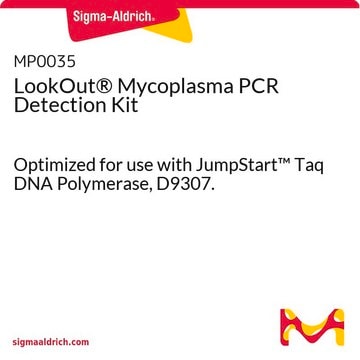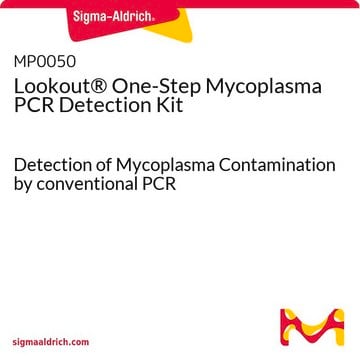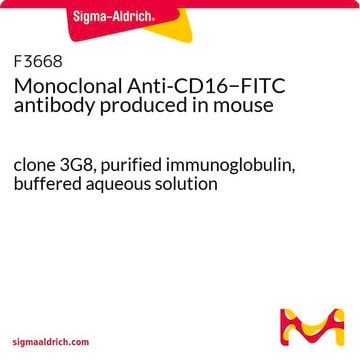The cell culture supernatant (sample) can be stored for several days at 4 °C before using the kit to determine if mycoplasma is present. For long-term storage, the samples can be stored at -20 °C, either in their native state or after heat inactivation.
MP0025
Venor™ GeM Mycoplasma Detection Kit, PCR-based
Synonyme(s) :
PCR mycoplasma detection kit
About This Item
Produits recommandés
Utilisation
kit sufficient for 25 tests
Niveau de qualité
Conditionnement
pkg of 1 kit
Conditions de stockage
dry at room temperature
Technique(s)
PCR: suitable
Application(s)
detection
microbiology
Température de stockage
2-8°C
Description générale
Application
Composants
Stockage et stabilité
Informations légales
Composants de kit seuls
- Positive Control
- Negative Control
- PCR 10X Reaction Buffer 500 mL/vial
- Primer/Nucleotide Mix 1 mL/vial
Code de la classe de stockage
10 - Combustible liquids
Classe de danger pour l'eau (WGK)
WGK 3
Certificats d'analyse (COA)
Recherchez un Certificats d'analyse (COA) en saisissant le numéro de lot du produit. Les numéros de lot figurent sur l'étiquette du produit après les mots "Lot" ou "Batch".
Déjà en possession de ce produit ?
Retrouvez la documentation relative aux produits que vous avez récemment achetés dans la Bibliothèque de documents.
Les clients ont également consulté
Articles
Know when to use antibiotics to prevent bacterial or fungal, mycoplasma, or viral contamination in cell culture and find suitable antibiotics or other biological agents.
Detect mycoplasma contamination in cell culture through the PCR, DNA stain, or culture tests. Discover mycoplasma prevention, elimination, and detection kits.
Overview on how to maintain proper cell culture laboratory safety including steps on performing lab risk assessments, surface disinfection, biohazard and waste removal. Free ECACC handbook download.
Overview of good cell banking practices for cell line cryopreservation purposes.
Protocoles
Mycoplasma contamination of cell cultures is a serious issue impacting cell model validity. PCR testing for mycoplasma is an inexpensive, sensitive, and specific method for detecting contamination.
-
Can the cell culture supernatant be stored for a period of time before using the kit to determine if mycoplasma is present?
1 answer-
Helpful?
-
-
Can I freeze the samples to collect several before using them?
1 answer-
Samples should be cell supernatants when possible. Cell pellets are not recommended. The high concentration of DNA in the pellet is often responsible for the non-specific bands. If cell pellets are the only material available for testing, then centrifugation is necessary following sample boiling in order to remove all cell debris.
Helpful?
-
-
What is the difference between Product No. MP0025 (VenorGem Mycoplasma Detection Kit) and Product No. MP0035 (Lookout Mycoplasma Detection Kit)?
1 answer-
The assay kits have a similar range of species detected (see product insert for listing). For Product No. MP0025, the components are supplied as individual reagents. For Product No. MP0035, the components are supplied in reaction tubes, already mixed and ready for addition of sample and Taq. The internal control for Product No. MP0035 is at 481 bp rather than 191 bp as found in Product No. MP0025.
Helpful?
-
-
Can a cell lysate be used in the VenorGeM® Mycoplasma Kit, Product MP0025, assay?
1 answer-
A cell lysate can contain PCR inhibitors. Sigma Aldrich recommends that PCR inhibitors be removed using a DNA extraction with commercially available kits. (Product Codes G1N10, G1N70, NA2000).
Helpful?
-
-
What is the Department of Transportation shipping information for this product?
1 answer-
Transportation information can be found in Section 14 of the product's (M)SDS.To access the shipping information for this material, use the link on the product detail page for the product.
Helpful?
-
-
The sample required for VenorGeM® Mycoplasma Kit, Product MP0025, is a cell culture supernatant. Is this from adherent or suspension cells?
1 answer-
The mycoplasma assay kit can be run on supernatants from either adherent or suspension cells. The centrifugation step during sample preparation will remove any cellular debris to limit PCR inhibitors.
Helpful?
-
-
Product MP0025, VenorGeM® Mycoplasma Kit, does not contain TAQ. What DNA polymerase should be used?
1 answer-
Any DNA polymerase with a 3’-5’ exonuclease activity is NOT recommended. These include Tli, Pfu,and Pwo. Those DNA polymerases that can be used include Taq, Tfl, and Tth. The kit has been optimized for use with Product No. D9307.
Helpful?
-
-
When using Product MP0025, VenorGeM® Mycoplasma Kit, there is inhibition in the sample (no internal control band). Can the sample be diluted and the assay repeated?
1 answer-
Sigma Aldrich does not recommend diluting the sample and re-assay as this can result in false negatives (sample diluted below the detection limits of the assay). Sigma Aldrich recommends that PCR inhibitors be removed using a DNA extraction with commercially available kits. (Product Codes G1N10, G1N70, NA2000).
Helpful?
-
Active Filters
Notre équipe de scientifiques dispose d'une expérience dans tous les secteurs de la recherche, notamment en sciences de la vie, science des matériaux, synthèse chimique, chromatographie, analyse et dans de nombreux autres domaines..
Contacter notre Service technique











